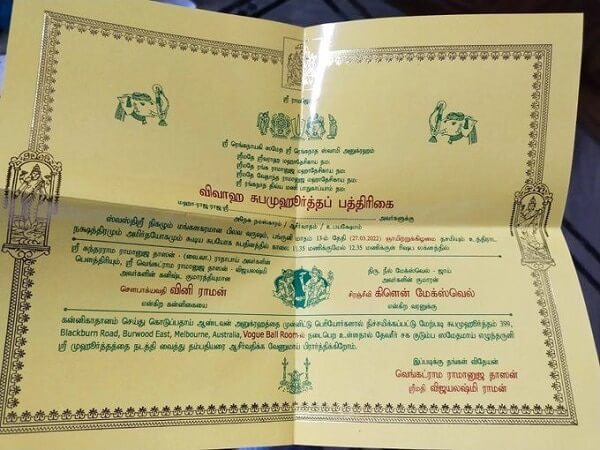It was a wedding invite that broke the Internet.
Groom-to-be Glenn Maxwell, Australian cricketer popular in India for his IPL appearances, made headlines when he claimed, “Look up Maxwell wedding, it’ll be somewhere.”
His upcoming nuptials to Melbourne-based Indian-origin physiotherapist Vini Raman became social media fodder in India when the invite was leaked online.
By the time the news hit Australia only days later, Maxwell was quoted as saying there could be security concerns for the wedding.
The young couple, who met in 2017 and who have now been engaged for two years, will get hitched on 27 March in Melbourne, in a traditional Hindu ceremony.
Australian cricketer @Gmaxi_32 goes all Indian in engagement to Vini Raman. Was spotted sporting a “sherwani” and a “tilak” on his forehead. pic.twitter.com/6x7F26fpOh
— Indian Link (@indian_link) March 17, 2020
We can safely assume it will be a lavish affair, given that Maxwell himself has described it as a festival-like wedding. (Fellow cricketer Brett Lee chose to call it “longer than a Test match”.)
Yet, that is not exactly the reason – or the only reason – the invite went viral in India.
Let’s allay some fears here: the leak, while a breach of privacy no doubt, was actually intended to highlight that somewhat rare traditional style of wedding invitation.
Sydney’s Usha Arvind, who belongs to the same community as bride-to-be Vini Raman, told Indian Link, “A photograph of the invite came to me on my family WhatsApp group, forwarded by an elderly aunt who commented that we are now embracing an Australian celebrity into the fold!”
She went on, “But really, the fascination came from the novelty of it all. For my family – and I’m sure for others in our Sri Vaishnava community – the admirable quality of it all was that a young Tamil woman born and raised in Australia, marrying someone from another race, had chosen to go with something so traditional in honour of her heritage. It gave us an inkling that the entire ceremony would be orthodox, and so it was great to see an Australian groom happy to embrace our traditions.”
The traditional invitation card (called the muhuratham patrikai) is quite unique, and probably serves as a notification, given Indian weddings are not typically registered in a court of law. Only a few copies are printed these days for each wedding, intended mostly for elders in the family or immediate family.
Usha remembers her own traditional Tamil wedding invite from more than 25 years ago, and described the format for us.
Figure-heading the invite is an image of the family deity, with salutations following.
The full backgrounds of both bride and groom are then listed, with details going back to grandparents. Especially noted are religious sects (mutts) and subsects to which the families belong; hereditary titles, and places of origin. Also important are names of family temple and family gurus.
Then follows time of muhurtham (the auspicious time for rituals in this particular wedding, based on astrological measurements).
The yellow background is also a standard; it represents the colour of turmeric, auspicious in a wedding ceremony.
“The first copy is presented to the family deity,” Usha described. “The temple then sends the wedding garlands to the bride and groom on the day of the ceremony.”
Melbourne’s Chitra Sudarshan, also of the same community as the bride-to-be Vini, added, “This is a convention that continues to this day. My brother had a few of these invitations printed for his daughter’s wedding recently.”
Usha said she will likely organise such invitations for her own children’s weddings.
“Of course, also accompanying, is a standard English invite in the modern form,” she clarified.
Contemporary Tamil weddings follow the multiple-event format that is in vogue across India now, in which the wedding ceremonies take place over days. Different people are invited to different ceremonies, depending on how close they are to the bride or groom or their families. And so the typical wedding invite is really a booklet, with dates and times of the various ceremonies, to which you RSVP separately.
Also, no wedding invite goes out without accompanying sweetmeats, so that the entire thing becomes a box that has to be hand-delivered. Often bejewelled, an ‘invite-box’ can become a treasured keepsake.
It can be quite a thrill to be at the receiving end of such an ‘invite-box’, as guests of Vini and Glenn might have discovered in weeks past.
In the traditional Tamil fashion, we wish the young couple Inniya thirumanna vaazthukkal (Hearty congratulations on the auspicious occasion of your wedding).
READ ALSO: ‘The boys have my back’: Pat Cummins’ kind gesture for Usman Khawaja wins hearts





